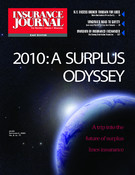Most crash deaths occur on rural roads, but motorists drive two billion miles every day on urban arterial roads where about 8,000 deaths and more than 1 million injuries occur each year.
The crashes aren’t occurring haphazardly; many of these accidents happen in predictable locations and involve predictable sequences of contributing events, according to safety experts.
Remedies can involve costly and disruptive re-engineering of the roadways–but not always. As the Insurance Institute for Highway Safety demonstrated by studying and then reworking a major arterial roadway in Virginia with the help of state transportation officials, some relatively simple and inexpensive roadway changes can be effective.
“Urban arterials weren’t built to accommodate today’s heavy traffic. They’ve evolved as traffic has increased, and they haven’t always evolved in the best way to enhance safety and ensure a smooth flow of traffic,” says Richard Retting, senior transportation engineer at the Insurance Institute for Highway Safety.
“So it’s a matter of studying urban arterials to pinpoint where crashes are occurring frequently and then identifying potential solutions, looking first for less costly measures that can be implemented more quickly than major re-engineering,”
Retting led a project involving Leesburg Pike in suburban Fairfax County, Virginia, near Washington, D.C. The researchers studied traffic on the roadway, identified problems that were causing crashes, and then applied measures like adding protected left-turn signals at problem intersections or moving a bus stop a few hundred feet. At two of the six locations where such measures were applied, certain crash types were reduced to zero. At four other intersections, the targeted crashes were significantly reduced.
The insurance industry’s findings came following a government report that traffic deaths declined on U.S. highways for a second straight year, with 42,636 fatalities in 2004, a reduction of 248 from the previous year.
Leesburg modifications
On the Leesburg Pike, Rettig’s teams found that in one intersection, westbound motor-ists found it difficult to make a left hand turn across several lanes of heavy traffic driving at the intersection with Lewinsville Road. The speed limit for oncoming traffic is 45 mph, so vehicles often approach this intersection at relatively high speeds. To make matters worse, the view of oncoming traffic often is obscured by eastbound vehicles, especially trucks and buses waiting to turn left. These factors contributed to potentially serious side impacts involving left-turning vehicles To remedy the matter, The Virginia Department of Transportation installed a left turn signal for motorists and adjusted the timing of the traffic signal to improve traffic flow. The results have been convincing. The intersection had an average of 4.6 left turn crashes every year before the changes. In the more than two years since the changes, there haven’t been any crashes at the intersection.
Other crashes were reduced by extending a merge lane from Westpark Drive onto Leesburg Pike. This reduced the queue of motorists waiting to merge and cut rear-end crashes from an average of 8.2 annually before the merge lane was extended to less than one afterward
At the intersection of Leesburg Pike and Patterson Road, rear-end crashes into stopped or stopping vehicles were associated with a bus stop. Researchers took note of another nearby bus stop and suggested eliminating the one at Patterson. Once this stop was removed, rear-end crashes declined from an average of 3.5 per year to 1.4. A similar improvement was accomplished at Magarity Road by widening the shoulder of Leesburg Pike two feet to accommodate buses. This way bus drivers no longer have to stop in traffic and interrupt the flow of vehicles. Rear-end crashes have declined from 4.3 per year to 2.5.
Cost-effective
Ryan Hall, a Virginia DOT spokesman, said the cost for the changes sought by IIHS varied, with a left turn signal costing from $30,000 to $50,000. Extending a merger lane can be completed for about $10,000 if there is no land acquisition involved, he said.
Adding a left hand turn lane can be more expensive, depending on whether the state needs to acquire land. The extra lane can cost between $150,000 to $250,000 with a right of way acquisition, he said.
VDOT’s spokesperson Connie Sorrell said officials hope to address other roads in the future. “We applied some straightforward engineering improvements that were effective and not very costly. We’re looking to use these and similar measures elsewhere,” she said.
According to Retting, since every site is different, it needs to be evaluated on an individual basis but the results in Virginia should be instructive for other states and municipalities.
“We didn’t set out just to improve Leesburg Pike,” Retting pointed out. “We wanted to create a model for local officials nationwide to improve safety and traffic flow in their own areas. Officials can systematically study their arterials and identify problems. They should seek remedies besides the ones we’ve spelled out for Leesburg Pike because every urban arterial is different.”
Topics Virginia
Was this article valuable?
Here are more articles you may enjoy.


 AIG Files Amended Suit Against Former Execs, Dellwood Insurance
AIG Files Amended Suit Against Former Execs, Dellwood Insurance  The Battle Over J&J’s Bankruptcy Plan to End Talc Lawsuits
The Battle Over J&J’s Bankruptcy Plan to End Talc Lawsuits  Deere Retreats From Diversity Measures After Online Attacks
Deere Retreats From Diversity Measures After Online Attacks  Abbott Accused at Trial of Hiding Fatal Risk of Infant Formula
Abbott Accused at Trial of Hiding Fatal Risk of Infant Formula 


